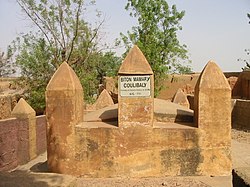
Back Imperiu de Bamana AST بامبارا ایمپراتورلوغو AZB Bamana Mansamara BM Rouantelezh Bambara Segou Breton Imperi Bambara Catalan Reich von Bambara German Imperio de Bamana Spanish Segu Finnish Royaume bambara de Ségou French Kekaisaran Bamana ID
Bamana Empire | |||||||||
|---|---|---|---|---|---|---|---|---|---|
| 1712–1861 | |||||||||
 Bamana Empire or Ségou Empire at XVIII century. | |||||||||
| Capital | Ségou | ||||||||
| Common languages | Bambara | ||||||||
| Religion | Animism, Islam | ||||||||
| Government | Monarchy | ||||||||
| Faama | |||||||||
• 1712-1755 | Mamary Coulibaly | ||||||||
• 1766-1790 | Ngolo Diarra | ||||||||
| Historical era | Early modern period | ||||||||
• Kaladian establishes dynasty | c.1640 | ||||||||
• Mamari (Biton) Coulibaly takes power | 1712 | ||||||||
• Ngolo Diarra takes power | 1766 | ||||||||
• Conquest by the Toucouleur Empire | 1861 | ||||||||
| Currency | cowries, mithqal | ||||||||
| |||||||||
| Today part of | Mali | ||||||||

The Bamana Empire (also Bambara Empire or Ségou Empire, Bambara: ߓߊ߲ߓߊߙߊ߲߫ ߝߊ߯ߡߟߊ, romanized: Banbaran Fāmala) was one of the largest states of West Africa in the 18th century.[1]: 408 Along with Kaarta it was one of the most important successors of the Songhai Empire. Based on an earlier kingdom established in 1640, it grew into a powerful empire in the early 18th century under Bitòn Coulibaly. The empire existed as a centralized state from 1712 until the 1861 invasion by the Toucouleur conqueror El Hadj Umar Tall.
- ^ Green, Toby (2020). A Fistful of Shells. UK: Penguin Books.